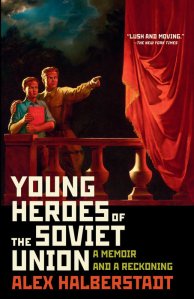Book Review: Alex. Young Heroes of the Soviet Union: A Memoir and a Reckoning by Alex Halberstadt
- schiffnerhs
- Jan 12, 2021
- 3 min read
Halberstadt, Alex. Young Heroes of the Soviet Union: A Memoir and a Reckoning. Random House, 2020.
Book review by Katherine Allocco (Western Connecticut State University)
Alex Halberstadt’s Young Heroes of the Soviet Union redefines the genre of memoir creating something complex and compelling. He begins his memoir with the central question: Can trauma be inherited? He then recounts the history of the Soviet Union intertwining it with the history of four generations of his own family who struggled against persecution, anti-Semitism and economic hardship throughout the course of the twentieth century all the while analyzing global and personal events through his central organizing question.

Halberstadt, who immigrated to the US with his mother and her parents in 1980 when he was 10 years old, returned to Russia in 2004 in the hopes of uncovering his family’s untold stories and secrets by meeting his paternal grandfather, who had once worked as Stalin’s bodyguard. As he walked the vaguely familiar streets of Moscow and spoke with his family members, his goal expanded. He realized that his grandfather’s proximity to Stalin had shaped and molded not only his grandfather but also multiple generations of his family who had to adapt to the fear and trauma that pervaded all of the USSR via Stalinist policies. Halberstadt’s narrative shifts from the past to the present and back again and from Moscow to Lithuania to New York as he draws connections between familiar behavioral patterns with his family and on the national stage. Halberstadt’s book illustrates how profoundly national tragedies affect families for generations to come.
Reading this book provides the reader with a clear history of the violence, anti-Semitism, and authoritarianism that defined the Soviet government and culture throughout the twentieth century. Halberstadt also explores themes of identity as he carefully examines his own experiences with immigration, poverty, and sexuality. His intensely personal narrative and collection of family photos enhance the reader’s understanding of the Nazi invasion of Lithuania, the nearly lawless activity of the Red Army, collective agriculture, anti-Semitic pogroms, and the rise of the KGB. One of this books’ greatest strengths too, is the author’s description and analysis of Soviet architecture as he describes his childhood relationships with the gigantic and propagandistic buildings and statues erected throughout the USSR. Halberstadt deftly invites the reader into his physical and emotional landscape and allows us the opportunity to understand the myriad of ways that we are molded by our own family and our immediate cultural moment as well as the many ways that trauma can, in fact, be inherited and passed from one generation to the next.
This book would be a perfect addition to the required texts on any syllabus: History, Sociology, Psychology, Gender and Sexuality Studies, Immigrant Studies, Jewish Studies, and Writing. It would serve as an excellent example for any class on memoir writing. But most of all, this moving and poignant book is simply enjoyable to read in part because it is so beautifully written. Halberstadt, who is a widely published and highly respected journalist, is a very gifted writer. (I highly recommend his 2017 article in Saveur, “Is the World’s Best Butter Worth $50 a Pound?”.) This book can be devoured and appreciated by any reader who upon finishing it will walk away filled with a strong desire to call home.





Comments